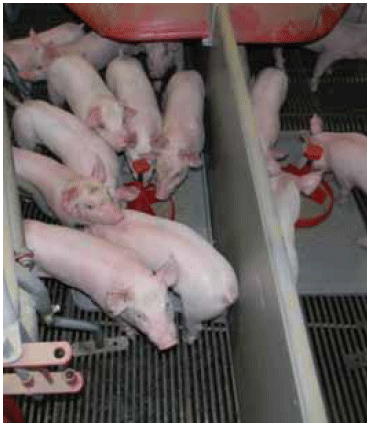



Creep Feed Provision in the Farrowing Room Provides Benefits to Piglets Showing Evidence of Intake
Creep feeding improves weaning and nursery exit weights for those pigs that actually eat, concluded N. Bandara, J. Shea, D. Gillis and A.D. Beaulieu from their study reported in the 2011 Annual Report from the Prairie Swine Centre.Summary
The consumption of creep feed improved growth rates and nursery exit weights. However, only about 40 per cent of the piglets offered the creep feed consumed it.

Introduction
Offering supplemental feed in farrowing (creep feeding) is thought to benefit piglets by:
- providing supplemental nutrition
- aiding the adaptation of the gastrointestinal tract to nutrients not found in milk, including proteins and
- introducing solid feed to the piglets.
However, a study published in last year’s annual report (Beaulieu et
al., 2010. Annual Research Reports. Weaning at 28 days. Is creep
feeding beneficial?) provided data showing that the provision of
creep feed in the farrowing room for seven days prior to weaning had
no effect on weaning weights, suggesting offering creep did not increase
overall nutrient intake. Surprisingly, this conclusion was the
same for the light and heavy pigs within a litter. Moreover, this data
showed that piglets from litters offered creep in farrowing were less
inclined to visit the feeder in the nursery immediately post-weaning.
This implies that there were no behavioural benefits from the
early introduction of solid feed.
This experiment however, was only able to describe the effects
of offering creep feed to a litter on performance. The authors
measured creep feed disappearance but were unable to determine
if consumption was equal among litter-mates.
The
objective of the current experiment, was to determine effects
of creep feed provision in the farrowing room, specifically among those piglets who show evidence of consumption.
Materials and Methods
One hundred sows were randomly assigned to one of two treatments – creep or no creep. The creep treatment piglets received creep feed (commercial) for one week prior to weaning. The creep feed was provided in multi-space creep feeders, added in 250-gram allotments as needed. The creep feed and the phase 1 nursery diets were marked with a non-toxic inert dye. Anal swabs taken from each piglet in the creep group 1 day prior to weaning and from all piglets on day 2 in the nursery allowed the researchers to estimate performance responses to creep among those piglets who had actually consumed it and further if consuming creep in the nursery actually encourage intake of the phase 1 diet immediately post-weaning.


Results and Discussion
Creep feed disappearance was approximately 240g per day
per farrowing crate. Although birth weight was similar between
groups regardless of subsequent creep feeding, weight at 21 days of
age (when creep feeding actually began) was higher (Table 1). All
litters had been treated exactly the same up to this point, thus, the authors cannot attribute this difference to treatment.
There was no difference in weaning weights and average daily gain (ADG)
from day 21 (when creep was offered) to weaning
was higher in those litters offered creep. Similar to
what had been observed in previous experiments,
providing creep in the farrowing room had no impact
on subsequent overall growth of those litters
in the nursery (Table 1).
The data in Table 2 is only from those litters offered
creep feed in the nursery. Approximately 37 per cent (175 out of 471) of piglets offered creep showed
evidence of consumption after five days. Within the
creep “eaters”, 45 per cent had evidence of consuming
the phase 1 diet when swabs were taken 48 hours
after weaning. Within the creep “non-eaters”, this
figure was 55 per cent. This corroborates the previous experiment
where video-tape observations showed
that piglets from litters offered creep had fewer
“feeder approaches” during the first 24 hours post-weaning.
Growth rate during the first three days post-weaning, of piglets classified as “creep and nursery eaters” was improved relative to other groups (Table 2). Moreover, there is evidence that this
improvement was maintained throughout the nursery period.

Conclusion
Creep feeding improves weaning and nursery exit weights, for those piglets who actually consume it. Further work is required to determine why not all piglets consume the creep feed and if these piglets will show improvements in growth if they can be encouraged to consume the creep feed.
July 2012






